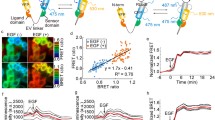Abstract
Transgenic mice play a significant role in modern biomedical research. They allow not only mechanistic insights into the functions of specific genes and proteins. Recent strategies have also established the use of transgenic mice as an exciting tool for the expression and in vivo or in situ analysis of fluorescent biosensors, which are capable of directly reporting second messenger levels and biochemical processes in real time and in living cells. In this chapter, we present a detailed protocol for the generation of plasmid vectors and transgenic mice expressing a Förster resonance energy transfer (FRET)-based biosensor for the second messenger 3′,5′-cyclic adenosine monophosphate. These tools and techniques should provide great potential for the analysis of second messenger dynamics in a more physiologically relevant context.
Access this chapter
Tax calculation will be finalised at checkout
Purchases are for personal use only
Similar content being viewed by others
References
Klohs J, Rudin M, Shimshek DR et al (2014) Imaging of cerebrovascular pathology in animal models of Alzheimer’s disease. Front Aging Neurosci 6:32
Zheng Y, Kong Y, Li F (2014) Kruppel-like transcription factor 11 (KLF11) overexpression inhibits cardiac hypertrophy and fibrosis in mice. Biochem Biophys Res Commun 443:683–688
Levy E, Spahis S, Garofalo C et al (2014) Sar1b transgenic male mice are more susceptible to high-fat diet-induced obesity, insulin insensitivity and intestinal chylomicron overproduction. J Nutr Biochem 25:540
Scharfenberger L, Hennerici T, Kiraly G et al (2014) Transgenic mouse technology in skin biology: generation of complete or tissue-specific knockout mice. J Invest Dermatol 134:e16
Liu C, Xie W, Gui C et al (2013) Pronuclear microinjection and oviduct transfer procedures for transgenic mouse production. Methods Mol Biol 1027:217–232
Gordon JW, Scangos GA, Plotkin DJ et al (1980) Genetic transformation of mouse embryos by microinjection of purified DNA. Proc Natl Acad Sci U S A 77:7380–7384
Tian XL, Wang QK (2006) Generation of transgenic mice for cardiovascular research. Methods Mol Med 129:69–81
Lohse MJ, Bünemann M, Hoffmann C et al (2007) Monitoring receptor signaling by intramolecular FRET. Curr Opin Pharmacol 7:547–553
Nikolaev VO, Bünemann M, Schmitteckert E et al (2006) Cyclic AMP imaging in adult cardiac myocytes reveals far-reaching beta1-adrenergic but locally confined beta2-adrenergic receptor-mediated signaling. Circ Res 99:1084–1091
Zaccolo M (2004) Use of chimeric fluorescent proteins and fluorescence resonance energy transfer to monitor cellular responses. Circ Res 94:866–873
Börner S, Schwede F, Schlipp A et al (2011) FRET measurements of intracellular cAMP concentrations and cAMP analog permeability in intact cells. Nat Protoc 6:427–438
Nikolaev VO, Bunemann M, Hein L et al (2004) Novel single chain cAMP sensors for receptor-induced signal propagation. J Biol Chem 279:37215–37218
Calebiro D, Nikolaev VO, Gagliani MC et al (2009) Persistent cAMP-signals triggered by internalized G-protein-coupled receptors. PLoS Biol 7:e1000172
Niwa H, Yamamura K, Miyazaki J (1991) Efficient selection for high-expression transfectants with a novel eukaryotic vector. Gene 108:193–199
Cho A, Haruyama N, Kulkarni AB (2009) Generation of transgenic mice. Curr Protoc Cell Biol. Chapter: Unit–19.11. doi: 10.1002/0471143030.cb1911s42
Acknowledgment
The work in authors’ laboratories is supported by the Deutsche Forschungsgemeinschaft (grants NI 1301/1, FOR 2060, SFB 1002 TP A01, IRTG 1816), the German Centre for Cardiovascular Research (DZHK), and the University of Göttingen Medical Center (“pro futura” grant).
Author information
Authors and Affiliations
Corresponding author
Editor information
Editors and Affiliations
Rights and permissions
Copyright information
© 2015 Springer Science+Business Media New York
About this protocol
Cite this protocol
Hübscher, D., Nikolaev, V.O. (2015). Generation of Transgenic Mice Expressing FRET Biosensors. In: Zaccolo, M. (eds) cAMP Signaling. Methods in Molecular Biology, vol 1294. Humana Press, New York, NY. https://doi.org/10.1007/978-1-4939-2537-7_9
Download citation
DOI: https://doi.org/10.1007/978-1-4939-2537-7_9
Published:
Publisher Name: Humana Press, New York, NY
Print ISBN: 978-1-4939-2536-0
Online ISBN: 978-1-4939-2537-7
eBook Packages: Springer Protocols




